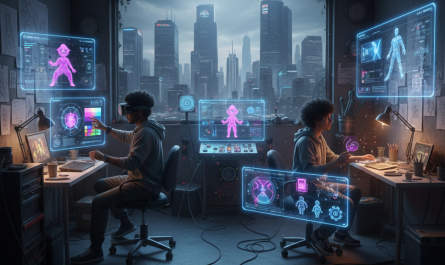Introduction
Artificial Intelligence (AI) is redefining industries, and creatives are at the forefront of this transformation. Coca-Cola, one of the world’s most iconic brands, is setting an example of how to integrate generative AI into campaigns to enhance creativity and engagement. Its latest installment in the ‘Real Magic’ brand platform, the captivating global ad titled ‘Masterpiece,’ showcases the transformative power of AI in art while featuring Andy Warhol’s iconic painting of a Coke bottle.
This visually stunning ad employs a fusion of live action, digital effects, and stable diffusion AI to create a mesmerizing animation style. However, despite receiving positive reviews for its creativity and appeal, strategic adjustments could further optimize its impact. Let’s explore how Coca-Cola’s ‘Masterpiece’ campaign utilized AI tools and techniques to merge technology with creativity and how such campaigns can be refined for greater engagement and emotional resonance.
Why is this blog important?
The adoption of AI in creative industries is accelerating. According to a report by Grand View Research, the global AI market is expected to grow at a CAGR of 37.3% from 2023 to 2030. Coca-Cola’s generative AI initiatives offer valuable lessons for creatives, agencies, and brands looking to stay ahead of the curve by combining technological innovation with human ingenuity.
1. Coca-Cola’s Commitment to Generative AI
Coca-Cola’s generative AI strategy became evident with the appointment of Pratik Thakar as its global head of generative AI. Thakar believes AI bridges the gap between brand identity and human creativity, making tools more accessible to a diverse audience. This approach underscores Coca-Cola’s mission to democratize creativity and redefine how brands connect with audiences.
Key Takeaway:
AI can enhance brand identity and creativity when used responsibly. Ethical considerations, such as ensuring fairness and transparency in AI model training, are critical to its success.
2. The AI-Driven ‘Masterpiece’ Campaign
Coca-Cola’s ‘Masterpiece’ ad is a testament to the possibilities of AI-powered storytelling. Developed in collaboration with OpenAI, Bain & Company, and other creative partners, the ad utilized:
- DALL-E 2 for generating AI-augmented animations.
- Stable Diffusion AI to create a mesmerizing animation style blending live-action and digital effects.
- ChatGPT for brainstorming and script development, ensuring cohesive storytelling.
The ad not only captivates with its stunning visuals but also highlights Coca-Cola’s commitment to fusing art with technology. Featuring iconic artworks like Andy Warhol’s Coke bottle, the campaign successfully communicates brand identity while inviting audiences to experience the enchantment of AI-infused art.
Lessons for Creatives:
- Visual Excellence: AI tools like DALL-E 2 and Stable Diffusion can elevate animation and storytelling.
- Human Input is Crucial: While AI handles technical tasks, the campaign relied on human creativity for concept and execution, proving that AI enhances rather than replaces human talent.
3. Insights from Emotional and Audience Analysis
Research tools like Empath’s AI-powered webcam eye-tracking and facial coding reveal key insights into the ad’s performance:
- Keeping Focus: While the ad captivates viewers towards the end, maintaining consistent engagement throughout its 2-minute duration remains a challenge. Ensuring strong opening scenes and memorable closing messages is vital.
- Emotional Peaks: Pivotal moments in the video evoke emotional spikes, making segments memorable and impactful. However, maintaining emotional resonance across the ad could enhance its overall effectiveness.
- Balancing Tone: Despite moments of negativity, positive and neutral responses dominate. User feedback commended the ad for its creativity, universal appeal, and magical quality, but addressing implicit boredom perceptions is key to sustaining engagement.
Key Takeaway:
Leveraging AI insights to refine content duration and align messaging with audience preferences can help bridge the gap between brand recall and emotional resonance.
4. Empowering Independent Creatives
Through initiatives like the Real Magic Creative Academy and Coke Studio, Coca-Cola is fostering relationships with independent creators and small studios. These programs provide tools for artists to explore AI’s potential:
- Create Real Magic: This campaign invited artists to use Coca-Cola’s assets to design visuals, with winners featured on billboards in New York and London.
- Coke Studio: Augmented with generative AI, this platform allows users to create music videos, songs, and album covers, democratizing creative opportunities.
The Big Picture:
While these initiatives empower creatives, they also raise important questions about how brands might control access to AI tools and influence the creative industry.
5. Refining Campaigns for Maximum Impact
Despite its success, the ‘Masterpiece’ campaign presents opportunities for optimization. Combining emotional analytics, user feedback, and AI insights can help Coca-Cola further enhance content engagement and brand perception.
Strategic Adjustments:
- Strengthen opening and closing scenes to capture and retain audience attention.
- Use AI tools to identify and amplify emotional peaks for maximum impact.
- Address implicit feedback suggesting boredom to sustain engagement throughout the ad.
Actionable Steps for Creatives:
- Utilize AI Insights: Tools like Empath’s emotional analysis can reveal what resonates most with audiences.
- Blend AI with Storytelling: Use AI for ideation and execution, but ensure a human touch for authenticity.
- Focus on Emotional Valence: Strike a balance between positive and neutral tones to enhance viewer experience.
Conclusion
Coca-Cola’s ‘Masterpiece’ campaign showcases the transformative potential of AI in advertising. By integrating AI tools like DALL-E 2, Stable Diffusion, and ChatGPT, the campaign bridges the gap between technology and creativity. However, addressing engagement and emotional challenges will be key to ensuring sustained success. By learning from Coca-Cola’s approach, brands and creatives can unlock new opportunities while preserving the essence of human creativity.
Does this interest you? Connect with us to see how we can help you elevate your campaigns with the power of AI!
10 Trending FAQs on AI Video Production
- What tools did Coca-Cola use for the ‘Masterpiece’ campaign?
Coca-Cola used DALL-E 2, Stable Diffusion, and ChatGPT for AI-driven animation and storytelling. - How does AI enhance video production?
AI accelerates workflows, generates visuals, and improves content personalization. - Can AI replace human creativity?
No, AI augments creativity but cannot replicate human storytelling and emotional depth. - What challenges did Coca-Cola face with its AI ad?
Maintaining consistent engagement and addressing implicit perceptions of boredom. - How can AI tools improve ad performance?
By analyzing emotional responses and optimizing content for target audiences. - What is Empath’s role in ad analysis?
Empath uses AI for emotional tracking, helping brands refine ads based on viewer reactions. - How can independent artists benefit from AI?
AI democratizes creativity, enabling artists to produce high-quality content affordably. - Is AI ethical in advertising?
Responsible practices, such as transparency and inclusivity, ensure ethical AI usage. - What is Coca-Cola’s Real Magic Creative Academy?
A platform to empower artists by providing access to AI tools and brand assets. - What’s the future of AI in advertising?
AI will continue to enhance personalization, interactive experiences, and creative workflows.
Some of the services that Clevertize provides are:
Creative Services, Performance & Digital Media Marketing, Visual Identity & Branding, Campaign Management & Analysis, UI/UX & Website design, Video creation, Media planning & buying, Chatbot & more.
If Return on Investment is critical for you, talk to Clevertize!
Reach out to us at saumya@clevertize.com!




